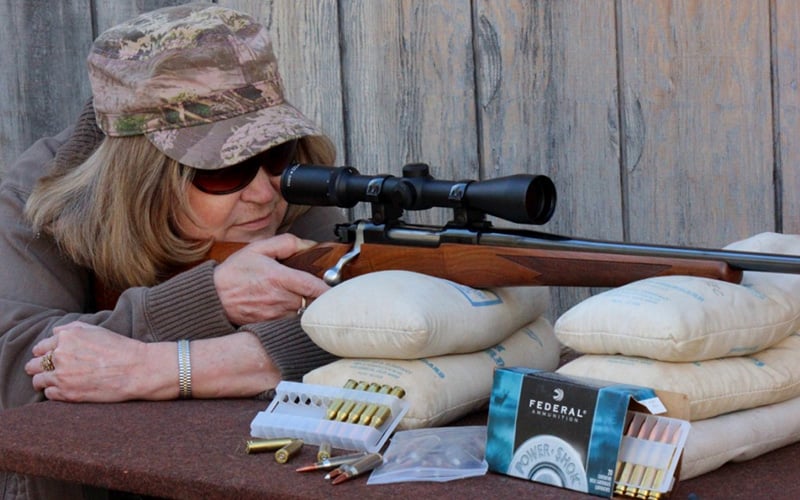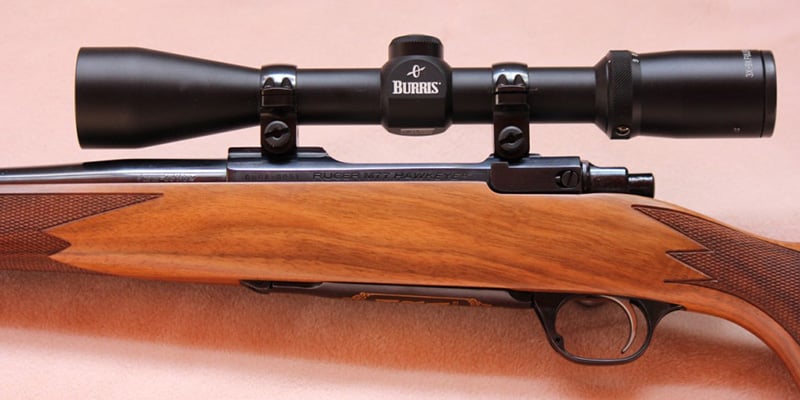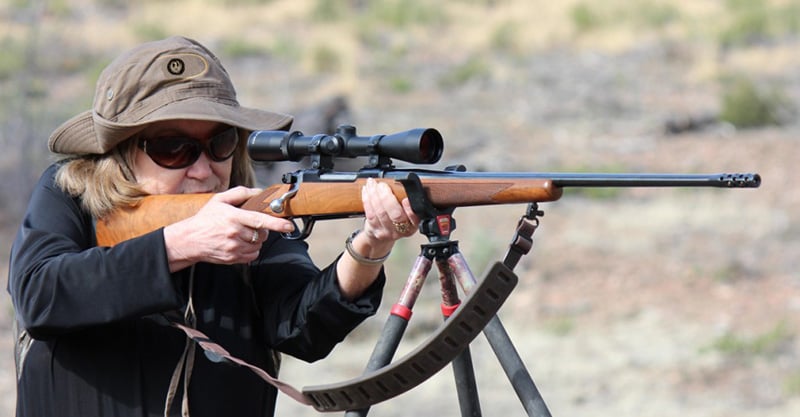
Last Updated on
By Tony Martins
The Ruger M77 Hawkeye in 7mm-08 Remington was the perfect answer to the question: What rifle should I buy for my non-hunting wife for her first big game hunting experience – a plains game trip to South Africa? I did my homework. Women appreciate beauty and style, as well as the potential to accessorize for individuality. Men typically lean more toward functionality and reliability. The Ruger M77 Hawkeye with slim ergonomics, a traditional walnut stock with extensive fine cut-checkering, hammer-forged alloy steel barrel and Mauser type claw extractor is a stylish, solidly built and American made hunting rifle that meets all of the “his” and especially “hers” criteria. It is affordable, as well as surprisingly accurate. Surprising only because there has been much written that is critical of its accuracy – too much in fact and unwarranted in my experience, but more on that later.
Ruger has a long history of building classic, durable bolt-action hunting rifles, and the M77 story dates back to 1968. Intended to be a modernized version of the Mauser 98, the M77 featured an investment cast rather than forged receiver, a new bolt design that replaced the Mauser blade style ejector with a plunger type ejector, and new safety and trigger systems. After a run of 20+ years, the M77 was retooled in 1991 with a new bolt to facilitate controlled round feed, new safety and trigger systems, and reintroduced as the Mark II. Gone were the adjustable trigger and the plunger ejector, which reverted back to the blade style. In 2006 Ruger gave this rifle a new name, Hawkeye. A new rounded profile stock, contoured to reduce muzzle lift under recoil was fitted, as was a new trigger system, the LC6 – designed to be lighter (“L”) and crisper (“C”) than its predecessor.
Now I will admit that eye appeal (hers) had a lot to do with our decision to go with the M77 Hawkeye rifle. The satin finished and elegantly grained American Walnut stock is certainly beautiful. My wife is a smallish 5’2” so handling characteristics and recoil were also important issues. Although we considered the compact model with its 16.5-inch barrel, the sporter styling and comparatively light weight (7 pounds) of the standard model made this rifle comfortable for her to handle, despite a full size 22-inch barrel. The longer barrel yields superior ballistics, and Ruger offers the standard model in nine calibers. We chose the 7mm-08, which is a fine all-around hunting cartridge that is widely available, and known for being light on both recoil and muzzle blast. Hmmm… since the smaller sized compact model proved unnecessary to fit my wife properly, I could maybe cozy up to this standard Hawkeye as well… done deal.
Anticipating that shots on our African plains game hunt would be no more than 200 yards I decided to mount a 3-9x40mm Fullfield II riflescope from Burris. The compact European styling makes this scope a nice match for the Hawkeye, and the excellent light transmission touted to be 95% provides a bright field of view, important for newby hunters and experienced ones as well. A set of 1-inch rings is included with every M77 rifle, a nice touch that can save you $50 to $80. These fit precisely into recesses cut into the sides of the receiver, and a tab on the bottom of each ring serves to lock it in place so the scope cannot move. The rear ring is slightly taller to insure that the scope is mounted parallel to the rifle bore, and we found when installed that the height of the scope was nearly perfect. Although the red rubber recoil pad that comes on the rifle is classy looking, we nevertheless replaced it with a shape-to-fit Limbsaver model, to well… accessorize! Other accessories included a claw style sling, and a beautifully crafted custom muzzle-brake, finished to match the matte blue metal of the Hawkeye standard. This was probably unnecessary, and although it added a bit more noise, it also insured there would be no complaints in the recoil department. Note: Of course, it’s nice to have a close friend who just happens to be a skilled gunsmith and machinist!
Anxious to ready the rifle for a weekend session at the range with wife Debbie, I picked up a couple of boxes of inexpensive Federal Power Shok ammo then stopped at a local cinder pit on the way home from work. With basic alignment from the M77 ring system, it took only a couple of shots and minimal scope adjustment to connect with an old metal drum lying in the pit. The LC6 trigger lived up to its name… well, partially. It broke crisply (“C”), though not what I would describe as lightly (“L”). Nevertheless, confident that I could hit a 12-inch square air filter box, I marked a bullseye and set it up at 100 yards. Shots #4, 5 and 6 printed a group that measured just a whisker over 1-inch – nearly MOA right out of the box! I saved that target to show Debbie and then fired a few more shots to adjust the zero. We had an enjoyable day at the range that weekend. Debbie burned a box of ammo while getting familiar with her new rifle – with no pressure to shoot a good group – and I tended to the cleaning and burnishing chores between shots to initiate proper break-in of the new barrel.
One of our friends worked up a few handloads for the new 7mm-08 Hawkeye, and we tested these over the next few weeks while completing the barrel seasoning. Although not an especially skilled or patient bench shooter, I was able to shoot sub-MOA groups with two different loadings: 140 grain Nosler Accubond bullets pushed by Hodgdon’s Varget powder to 2860 feet-per-second, and 140 gr. Barnes Triple-Shock X-bullets (TSX) over H380 powder at 2790 fps. As Debbie became comfortable with the rifle her groups tightened up, to a best of just over one inch with the Barnes loading off a bench rest. Obviously, the much maligned “heavy” trigger pull was not much of a problem. Now it was time for some practice to simulate hunting conditions we would encounter in Africa, so we did a few sessions in the field that included elevation changes, with rifle steadied atop shooting sticks. We found the Hawkeye to be well balanced and quite handy, and Debbie was quick to point and settle on targets with a little practice. Although her shot groupings understandably opened up some off the sticks, they would be more than adequate to cleanly dispatch plains game sized animals out to 300 yards. Considering a typical 8-inch kill zone and the exceptional downrange performance of the 7mm-08 round, the Point-Blank Range (PBR) is nearly 300 yards with her Hawkeye.
This is a good place for a few words about the 7mm-08 Remington cartridge. Born as a wildcat in the 1950’s, it is basically a .308 Winchester necked down to .284 in a slightly longer case. When silhouette shooting gained popularity in the late 1960’s, it didn’t take long for competitive shooters to recognize the inherent virtues of the nearly forgotten wildcat. These include flatter trajectory than the .308 or the .30-06 Springfield, with enough bullet weight for plenty of power to knock down steel targets, coupled with light recoil and mild muzzle blast. This renewed interest was all that Remington needed to lend its name and standardize the cartridge in 1980. It took a little longer for hunters to realize the field benefits of the 7mm-08 – light recoil (advantageous for youngsters and small adults as well as new shooters) combined with serious knock down power suitable for taking everything from varmints to moose efficiently and effectively.
Our Hawkeye rifle has performed flawlessly through the first 100 rounds, as would be expected of a Ruger. The controlled round feed and claw extractor work wonderfully, and both recoil and muzzle lift are minimal and easily managed by someone as small as my wife. Another nice feature of the Hawkeye is its three position safety, with a center position that allows the bolt to be opened while the gun stays in “safe” mode, to facilitate safe removal of individual rounds. And, the box style magazine can be emptied by depressing a lever recessed into the front of the trigger guard – another nice touch that enhances functionality while virtually eliminating accidental dumping of the magazine.
Clearly, there’s a lot to like about the Ruger M77 Hawkeye rifle. There are also a couple of things not to like, and both could conceivably have a detrimental effect on accuracy. First, the barrel is not free-floated, maintaining full contact with the wood from stock to tip of the forend. Many rifle shooters prefer a free-floated and/or glass-bedded barrel to extract the last bit of accuracy out of the gun. But, is this really necessary in a general purpose hunting rifle that shoots MOA with factory ammo and sub-MOA with handloads? Probably not. Second, although lighter than many factory triggers, the pull weight of the LC6 trigger is on the heavy side (ours breaks at 4.25 lbs.), and is not adjustable. This trigger is better than most, with no travel and a crisp break but let’s face it; there are superior triggers available in this class of rifle – like the AccuTrigger from Savage for example. Frankly, I prefer a lighter trigger and have several rifles set at 2.5 lbs. – but I have been shooting rifles for more than 50 years, and experience makes a difference in both capability and preference. Being an experienced rifle shooter, I have been able to shoot tighter groups with our Hawkeye than my much less experienced wife – but not that much tighter! Good trigger technique is important for accuracy with any rifle, but the key here is experience. As she gains experience and confidence with this rifle, her groups will certainly tighten. But, remember why we purchased this rifle… The intent was to get Debbie started on her way to becoming a hunter. At this point with the new Hawkeye she is feeling confident, and ready for most any game that we might encounter in the thornbush or on the plains of South Africa.
Most modern rifles are capable of better performance than the person holding them. And unlike many “gun” writers, I readily admit that despite considerable experience this basic though unpopular tenant would apply to my own performance. I suspect that installing an aftermarket trigger in the Hawkeye will improve its accuracy. One is available from Timney for about $125.00 but again, is this really necessary? This rifle was designed to be a stylish yet affordable and versatile hunting rifle, and it fits that bill nicely. It will probably never be a single-hole tack driver. So, if you want to split hairs on the forehead of prairie dogs at 500 yards, the Hawkeye may not be the rifle for you. That said, do its minor faults disqualify the otherwise well built, fine handling and attractive M77 Hawkeye rifle from purchase consideration as an all-around hunting rifle? I think not. Other writers have noted that this rifle is the type one cherishes and keeps – not to be traded away on a whim. I would agree. In fact, there’s a very good chance that my next rifle purchase will be another Hawkeye, in the .204 Ruger caliber.
The Line-up of Ruger Hawkeye Rifles
The Ruger Hawkeye family includes several specialized models and a wide range of calibers to suit almost every hunter and every hunting style. The flagship Hawkeye Standard, with American Walnut stock and satin blued finish is available in 9 calibers (.204 Ruger, .223 Rem., .243 Win., .270 Win., 7mm-08 Rem., 7mm Rem. Mag., .30-06 Sprg., .300 Win. Mag. and .308 Win.). The Hawkeye Compact sports a 16.5 inch barrel and either blued finished with walnut stock or stainless matte finish with black laminate stock, each available in 4 calibers (.223 Rem., .243 Win., 7mm-08 Rem. and .308 Win.). The matte stainless/black laminate combo is available in 5 calibers as the Hawkeye Varmint Target model (.204 Ruger, .22-250 Rem., .223 Rem., 6.5 Creedmoor and .308 Win.). The Hawkeye Predator comes in the same 5 calibers as the Varmint Target model, but includes a two-stage adjustable trigger to go with the stainless matte finish and Green Mountain laminate stock. The Hawkeye Magnum Hunter is available in .300 Win. Mag. only, with Hogue synthetic stock and matte stainless barrel with muzzle brake. 4 calibers are available in the Hawkeye African (.300 Win. Mag., .338 Win. Mag., .375 Ruger and .416 Ruger), each with walnut stock, blued finish, iron sights and the Ruger Muzzle Brake System, to tame recoil with these large magnum calibers.












Comments (2)
Jim Donohuesays:
March 3, 2015 at 10:14 pmGreat article on the M77. The writer is obviously qualified to offer honest feedback and a trusted opinion.
Very detailed and complete. Just might have to get myself one of these….. thanks!
Tony Martins | The Blog of the Gritr Sports Storesays:
June 23, 2015 at 2:35 pm[…] Ruger M77 Hawkeye: Why We Bought One, And Why I Would Buy Another […]
Nancy Jo Adamssays:
July 27, 2016 at 9:19 amI have the Ruger M77 Hawkeye .270 cal in the all-weather stock and metal finish. I absolutely love this rifle because of the weight, size and its accuracy. The ONLY think I dislike about this rifle and would immediately change with an after market product if it ever became available, is the magazine area. I REALLY dislike the way that this function works, spilling out all of your bullets and the accordion style innards that is truly just a pain to deal with. Not only is it very hard to open with the little push in bar to release it…just a very poor design that I truly was shocked Ruger passed from testing to market. But other than that one feature, I have shot many different species of big game with this rifle and love carrying it in the woods. #Ruger